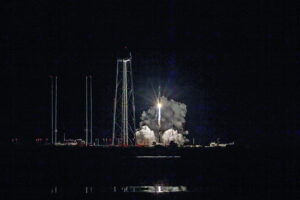
OCEAN CITY – After several scrubbed attempts over the last several weeks, a significant rocket launch from NASA’s nearby Wallops Flight Facility went up on Tuesday evening, arcing its way across the skies over the resort area.
Equipped with a revolutionary new NASA flight safety system, the private sector company Rocket Lab’s first-ever Electron rocket launch went up around 6 p.m. on Tuesday from the Wallops Flight Facility on the nearby Virginia eastern shore just south of Ocean City and Assateague.
The first-ever commercial launch of the Electron rocket, which stands over 50 feet tall, occurred during a window of crystal-clear skies before a front moved through the area the following day and was visible for many across the Eastern Shore and beyond. With the Wallops facility right in the Lower Shore’s back yard, residents and visitors in Ocean City, Assateague and the rest of Worcester County had a front row seat to the spectacle.
The launch was first planned for early December but was scrubbed five times through that month and into January. The mission marked the first time NASA’s new Autonomous Flight Termination Unit (NAFTU) was deployed on a launch from the U.S. NAFTU is a critical piece of flight safety technology required for the mission, and for future launches from Wallops.
“In taking NAFTU across the finish line, NASA has delivered an autonomous flight termination system like no other in operation today, filling a critical gap in modernizing the nation’s launch ranges,” said Wallops Flight Facility Director David Pierce after Tuesday’s successful launch. “We’re proud to have made this and future U.S. Rocket Lab Electron launches possible with our game-changing flight safety technology.”
While other proprietary autonomous flight termination systems are currently in use, NAFTU is different in that it is designed to be used by any launch provider at all U.S. launch ranges, including Wallops, to ensure public safety during operations. Ensuring public safety is the primary mandate of any launch range. Launches flying without automated flight safety systems have previously relied on range safety officers to monitor all stages of rocket flights using ground-based tracking and telemetry. If a rocket launch flies off course, the range safety officers send commands to terminate the flight, depending on human reaction time.
Rocket Lab’s Electron launch from Wallops on Tuesday delivered three low-orbit satellites as part of its mission. The mission was titled “Virginia is for Launch Lovers” in deference to the state’s popular slogan. Rocket Lab has successfully launched Electron rockets from other stations including New Zealand, but Tuesday’s launch from Wallops was the first successful one from the U.S.
The company’s launch sites can accommodate as many as 130 launch opportunities each year. Armed with the new NAFTU technology, Rocket Lab vowed to continue to deliver flexible and rapid launch capabilities for NASA and its private-sector partners.
“After our busiest launch year yet in 2022 with nine successful missions, what better way to kick off the new year than by launching a Virginia-based spacecraft from a launch site in Virginia,” said Rocket Lab founder and CEO Peter Beck. “Electron is already the leading small orbital rocket globally, and today’s perfect mission from a new pad is testament to our team’s unrelenting commitment to mission success.”
In the last decade or so, the Wallops Island Flight Facility has expanded its operations, creating hundreds of new meaningful and well-paying government and private sector jobs across the Lower Shore. The expanded presence at Wallops has also created millions of dollars in direct and indirect economic impact.
With the influx of federal funding, Wallops has flourished in recent years with several significant orbital and suborbital launches each year. There has also been some tourism-based economic benefit as visitors have flocked to various points along the shore to view the larger launches.

